How to get rid of mold in a washing machine using improvised means at home
Sometimes, after washing, instead of a pleasant smell of freshness, you can clearly feel the mustiness of the laundry from nowhere, and as a result of examining the electronic assistant, dark, slippery to the touch, raised spots are discovered in some areas.
Many washing machine users are concerned with the question: when mold appeared in the washing machine, how to get rid of it forever?
The content of the article:
What is mold and why is it dangerous?
Mold stains are colonies of very small fungi. If you look at them through a microscope lens, you can see threads (mycelium) and thickenings at their ends (spores). The latter are separated from the mother's body and travel with the air flow.
Mold spores can be found both outdoors and indoors. Hiding and not showing themselves in any way, they bide their time.
When favorable conditions occur, such as high humidity and warmth, the spores germinate quickly. As a result, colonies are formed, which are dark spots on some objects.

In nature, mold lives almost everywhere. These fungi play a very important role in the cycle of substances, helping to utilize organic residues.
Man has learned to synthesize a medicine from them, which has saved millions of lives.
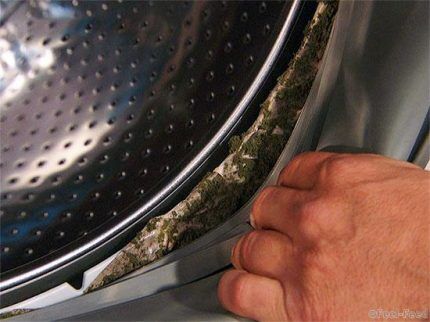
Mold produces a special toxic substance - mycotoxin. Penetrating into the human body in various ways, it causes the following symptoms:
- in case of contact with skin – irritation and itching;
- getting into the respiratory system - cough and shortness of breath;
- penetrating the gastrointestinal tract and disrupting the functioning of the normal microflora present there - bloating, diarrhea, constipation;
- absorbed into the bloodstream and entering nerve cells - weakening of attention and memory.
Therefore, if colonies are discovered in the house, you should immediately begin to destroy them.
Causes of mold
There are many reasons why a washing machine becomes infected with mold. But almost always the owners of the unit are to blame for the increased proliferation of fungus because they do not follow the rules for caring for household appliances.
Reason #1 - installation in the wrong place
As mentioned above, mold can grow and multiply rapidly only in appropriate conditions. Ideally, this is 90% humidity and +20 °C temperature. Small deviations from these indicators are also quite acceptable for microscopic fungi.
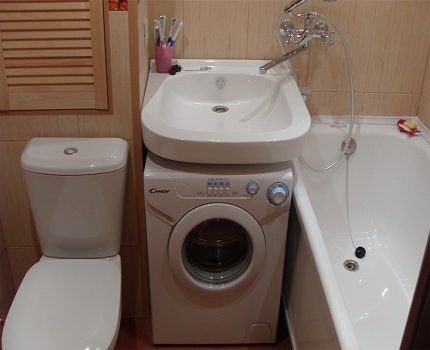
In a person’s home, such conditions are maintained in the bathroom all year round, so installing a washing machine here is extremely undesirable.
For this purpose, a kitchen or hallway is more suitable. If there is no choice and installation is possible only in the bathroom, you should definitely take care of good ventilation.
Reason #2 - the door is always closed
After the wash is finished and the laundry is removed from the drum, very often the owners tightly close the loading hatch door. Do the same with the reservoir for filling the powder.
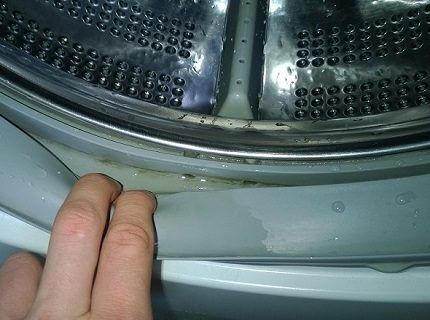
As a result, drops of water remaining inside the machine after washing create excellent conditions for the life of mold fungi.
At the end of the wash, a certain amount of water almost always remains in the folds of the rubber cuff, which acts as a seal for the door. Gradually it will evaporate, which is guaranteed to provide high humidity inside the machine. This is exactly what mold spores need to grow rapidly.
Reason #3 - washing at low temperatures
In order to save energy, owners constantly wash in low-heated water. This is fraught with the fact that the components of the washing machine are not disinfected at high temperatures.
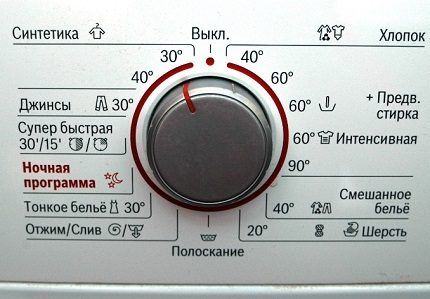
Reason #4 - improper use of detergents
In particular, we are talking about using powder without bleach. Whitening additives in washing powders not only restore the original appearance of light-colored clothes, but are also disinfectants that can defeat harmful fungus.
However, it is not at all necessary to constantly use these detergents. Alternating through 3-4 washes with regular powder is enough.

Another possible reason is incorrect washing with fabric softener. When washing with conditioner, be sure to run an extra rinse.
If this is not done, again for reasons of economy or simply due to ignorance, particles of rinse aid remain on the door, in the folds of the rubber cuff, on the drum mesh and the walls of the tank. This breeding ground is perfect for mold growth.
Reason #4 - connection problems
Mold in the washing unit can be caused by improper connection to the sewer system. As a result, the water does not drain correctly and some of it remains inside the machine.
Stagnant, dirty water is the best way to promote the development of mold colonies.
We recommend reading our other article, where we described the process in detail connecting the washing machine to communications.
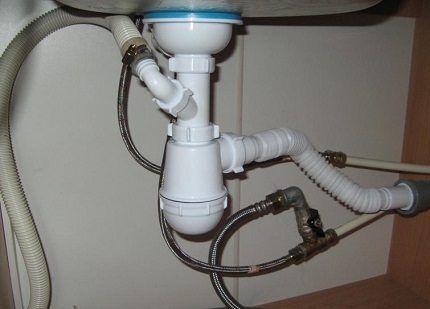
Home Mold Removal Methods
Before you start “saving” the washing machine, you need to understand what exactly fungi don’t like.
What they don’t like is the following:
- acidic environment;
- aggressive alkalis;
- high temperatures;
- dry surface.
Based on these indicators, you can always find the optimal remedy, after which the mold will go away once and for all.
Method #1 - cleaning with citric acid
This method is considered effective when no obvious traces of mold are visible in the car, but a musty smell is constantly felt. That is, when microscopic fungi have not yet had time to thoroughly settle in the unit.

Do it like this:
- Thoroughly wash and dry the compartment intended for filling the powder.
- Insert the tray back into the machine and fill it with citric acid. 200 g of substance is enough for cleaning.
- The control panel sets one of the washing programs, which provides for the use of water at the highest temperature.
- Run the wash cycle idle.
- At the end of the program, thoroughly wipe all accessible components of the machine with a dry cloth.
- The door and powder compartment are left ajar. This will keep the car well ventilated.
Citric acid method can be used for preventive purposes.To do this, once every 4-6 months you need to subject the equipment to the described procedure.
Method #2 - Cleaning the car with vinegar
Vinegar works on the same principle as citric acid. But the process of cleaning the device with this substance has some differences.
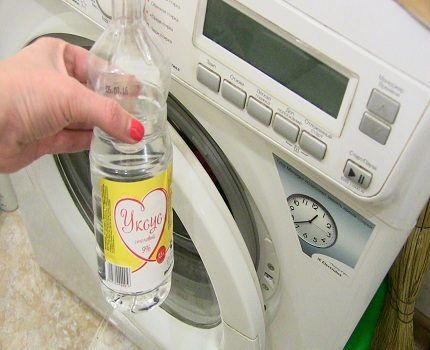
The technique is performed as follows:
- Half a glass of 9% acetic acid solution, which can be purchased at almost every grocery store, is poured into the powder compartment.
- On the control panel, select the longest program with the maximum temperature.
- Start the wash.
- After the water in the washing machine heats up well, press pause and wait an hour and a half.
- After time has passed, the machine is restarted to finish the wash.
- Make a solution in a separate container: 50 ml of 9% vinegar is added to 100 ml with water. Use this liquid to wipe all accessible surfaces of the washing machine.
- Choose the shortest program. They launch it.
An additional wash will help remove any remaining acid from the unit. After washing, wipe the car thoroughly, almost dry.
Using the described technique, you can eliminate not only mold, but also scale from your washing machine. Moreover, you should use exactly a 9% vinegar solution. Higher acid concentrations may damage unit parts.
Method #3 - using “Whiteness” and “Domestos”
If there is a lot of mold in the car, which can be judged by the numerous dark spots, household products designed to disinfect and cleanse sinks and toilets from dirt are used.
This is Belizna, known to our grandmothers, and more recent chlorine-containing preparations, for example, Domestos.

With their help, the car is freed from mold as follows:
- Select the longest program with a high temperature regime.
- Pour 1 liter of “Whiteness” or a similar product into the powder compartment.
- Start the cycle empty.
- When the water in the machine warms up well, stop the washing for 1-1.5 hours.
- The program is started again.
- After the washing is completed, pour 2 tbsp into the powder compartment. vinegar or add 200 g of citric acid.
- The rinse cycle is set on the control panel. They are launching.
At the end, wipe all accessible components well with a soft, dry cloth.
Chlorine is a poisonous substance, and its smell is not pleasant. Therefore, after cleaning the washing machine in this way, the room in which the unit is installed should be thoroughly ventilated.
Method #4 - treating the machine with copper sulfate
Copper sulfate or copper sulfate is a product successfully used in agriculture to combat plant diseases caused by fungi. You can find it in specialized gardening stores.
In appearance they are small blue crystals. It can also be used as a washing machine cleaner for mold. It should be borne in mind that vitriol is a strong poison, so you need to work with it very carefully.

The machine is treated with copper sulfate as follows:
- Prepare a solution by pouring 50 g of powder into a suitable container and bringing the volume to 5 liters.
- Wearing small rubber gloves on your hands, apply the product to the mold-affected areas with a sponge. Most often this is a cuff, a drum and a container for filling powder.
- The machine is left in this form for 3-4 hours.
- Close the hatch door and start the rinse program.
After the procedure is completed, the device is well ventilated. The copper sulfate treatment method is more suitable for cleaning heavily mold-contaminated washing machine components.
Method #5 - Cleaning with Soda Ash
Using this inexpensive product, you can clean your washing machine thoroughly and rid the unit of unpleasant odors.
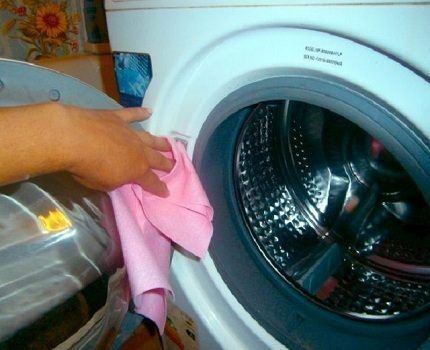
Cleaning with soda ash is carried out according to the following points:
- Soda powder is mixed with water in a 1:1 ratio.
- The resulting mixture is applied with a sponge to accessible parts of the machine: drum, rubber cuff, door.
- Wipe the compartment into which detergents are loaded well with baking soda.
- Leave the product to act for an hour and a half.
- After time, the soda ash, along with mold and dirt, is removed with a damp sponge.
- Turn on the machine in quick wash mode.
After the unit completes the program, wipe all components well with a dry cloth.Instead of calcium ash powder, you can use regular baking soda, but in this case the cleaning effectiveness will be less.
How to clear individual nodes?
Very often, colonies of mold fungi settle on the rubber cuff and in the compartment for filling the powder. To get rid of them, you need to thoroughly work on problem areas.
Removing mold from a cuff
Dirt and water often accumulate under the cuff, which serves as a seal for the loading hatch door, and in its folds. If mold appears, just wiping the outside with a rag, even with the use of appropriate chemicals, is not enough.
The following actions will be most effective:
- Using a tool, such as a screwdriver, pick up the wire clamp and move it in a circle, very carefully so as not to damage the rubber, remove the cuff.
- The part is washed well in a large container with water, detergent and bleach.
- Use a sponge soaked in a chlorine-containing solution to thoroughly wipe the drum and door.
The removed part is returned back only after all the components are dry. The mycelium of mold fungi can grow quite deeply into the rubber, so it is not always possible to completely wash the cuff.
In such cases, the situation can only be corrected replacing damaged tires to a new one.
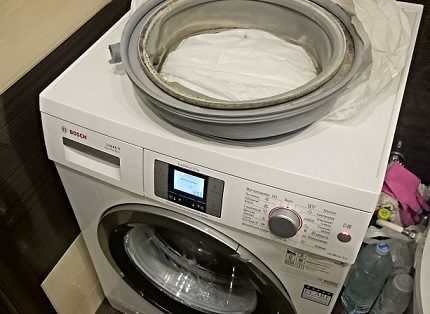
The nuances of cleaning the powder receptacle
The tray, designed to receive detergents and rinse aids, can be called the “dirty place” of the washing machine.
In addition, there is almost always some water left in it after the end of the program.Consequently, the compartment is a favorite place for mold colonies to settle.
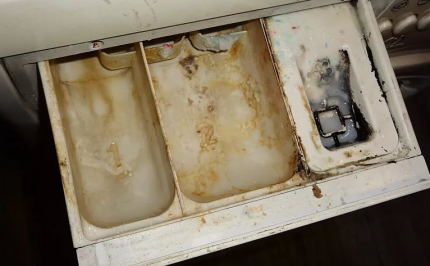
If mold appears in the powder receptacle, clean it as follows:
- The tray is removed from the machine and washed well under hot water.
- Warm water is poured into a suitable container and one of the chemicals is added there: Whiteness, Domestos, Toilet duck, Silit.
- Soak the compartment in the resulting solution for several hours.
- After time has passed, the tray is removed and thoroughly washed with a brush and rags alternately.
- Rinse well with clean water.
- Air dry and then return to place.
If the tray has barely noticeable traces of mold, then it is enough to clean it well with a brush under hot water. The drain filter, in which mold is often found, is also cleaned in the same way.
Prevention of fungus
To avoid mold growing in your washing machine, you should regularly follow simple prevention rules:
- Even for a couple of hours, you shouldn’t leave already washed clothes without removing them from the tank. If it is not possible to hang it up right away, then it is better to take it out into a basin.
- Once every 20-30 days you must wash it on a long program with high temperature. Be sure to use bleach powder as a detergent.
- In the interval from 3 to 6 months, you should start washing without laundry at high temperature with vinegar or citric acid added to the water. This will destroy mold spores that have not yet sprouted.
- Do not frequently use various fabric softeners and fabric softeners.Their particles remain on the walls and contribute to the development of microscopic fungi.
- Should be thoroughly cleaned periodically drain filter and a hose through which water from the machine flows into the sewer.
After each wash, be sure to wipe the rubber cuff and drum dry with a cloth.
It is better to remove the powder receptacle from the machine and thoroughly dry it in air. The hatch door for loading laundry should always be ajar.
Following these rules will prevent mold from settling inside the washing machine. As a result, the home assistant will work for a long time, efficiently and will not cause harm to the health of family members.
Conclusions and useful video on the topic
Advice from users who have already tried various methods for cleaning mold from a machine will help you understand some of the nuances of the process.
Useful information from the experience of cleaning a washing machine:
An experienced housewife will tell you how to care for a washing machine:
Simple rules of prevention and timely cleaning will provide reliable protection for your washing machine from extremely undesirable settlers - mold fungi..
If the problem has made itself felt, then, armed with the proposed methods and regularly carrying out preventive cleaning the washing machine, it will be much easier to deal with.
Perhaps you know other effective methods for eliminating mold in a washing machine and use them successfully? Please tell our readers about them - leave your comments and ask questions in the block below.




When the car is new, it's so pretty! Clean, shiny, odorless.I had to change the machine, and at first you put laundry into it with great pleasure. It comes out perfectly clean and fresh. I prefer to clean my car with soda ash. I’m somehow afraid to use products like Domestos, and it seems to me that citric acid is of little use.
And rightly so. Domestos is an aggressive cleaner containing chlorine; manufacturers do not recommend their use. Harmful to the “internals” of the washing machine.
Hello. Domestos is not intended for cleaning washing machines, but it can be used for cleaning the feed tray, disconnected from the general structure. I am for specialized products, but lemon juice really cleans well.
We bought a used washing machine from the guys at the service center after repairs. In general, its condition was not bad, it was given a guarantee. When they brought it to us, we were faced with the question of how to wash it, because there was mold on the elastic band, and there was a musty smell; the door had not been opened for a long time. We washed everything with vinegar and partially removed it. There is also a good way to get rid of odors and mold: this is to run a program at 90 degrees with citric acid (a couple of packs will be enough). He helped us, the machine is now like new and without odors.
We also got mold, right on the rim. We were able to get rid of it, but the last time the master visited, he warned that we should try not to wash at 30 degrees. Since then we switched to 60, and mold didn’t seem to appear anymore. We bought some other product for the smell in the car. I don’t remember which one, but everything has passed since then.You must not start the car, because mold may appear inside, where it is impossible to get it yourself and you will have to spend a lot of money on calling a technician and cleaning the car. Well, or even buy a new one.